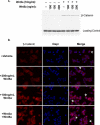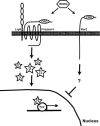Purified Wnt5a protein activates or inhibits beta-catenin-TCF signaling depending on receptor context
- PMID: 16602827
- PMCID: PMC1420652
- DOI: 10.1371/journal.pbio.0040115
Purified Wnt5a protein activates or inhibits beta-catenin-TCF signaling depending on receptor context
Abstract
The Wnts comprise a large class of secreted proteins that control essential developmental processes such as embryonic patterning, cell growth, migration, and differentiation. In the most well-understood "canonical" Wnt signaling pathway, Wnt binding to Frizzled receptors induces beta-catenin protein stabilization and entry into the nucleus, where it complexes with T-cell factor/lymphoid enhancer factor transcription factors to affect the transcription of target genes. In addition to the canonical pathway, evidence for several other Wnt signaling pathways has accumulated, in particular for Wnt5a, which has therefore been classified as a noncanonical Wnt family member. To study the alternative mechanisms by which Wnt proteins signal, we purified the Wnt5a protein to homogeneity. We find that purified Wnt5a inhibits Wnt3a protein-induced canonical Wnt signaling in a dose-dependent manner, not by influencing beta-catenin levels but by downregulating beta-catenin-induced reporter gene expression. The Wnt5a signal is mediated by the orphan tyrosine kinase Ror2, is pertussis toxin insensitive, and does not influence cellular calcium levels. We show that in addition to its inhibitory function, Wnt5a can also activate beta-catenin signaling in the presence of the appropriate Frizzled receptor, Frizzled 4. Thus, this study shows for the first time that a single Wnt ligand can initiate discrete signaling pathways through the activation of two distinct receptors. Based on these and additional observations, we propose a model wherein receptor context dictates Wnt signaling output. In this model, signaling by different Wnt family members is not intrinsically regulated by the Wnt proteins themselves but by receptor availability.
Figures







Comment in
-
One signal, multiple pathways: diversity comes from the receptor.PLoS Biol. 2006 Apr;4(4):e131. doi: 10.1371/journal.pbio.0040131. Epub 2006 Apr 4. PLoS Biol. 2006. PMID: 20076560 Free PMC article. No abstract available.
References
-
- Logan CY, Nusse R. The Wnt signaling pathway in development and disease. Annu Rev Cell Dev Biol. 2004;20:781–810. - PubMed
-
- Polakis P. Wnt signaling and cancer. Genes Dev. 2000;14:1837–1851. - PubMed
-
- Reya T, Clevers H. Wnt signalling in stem cells and cancer. Nature. 2005;434:843–850. - PubMed
-
- Shimizu H, Julius MA, Giarre M, Zheng Z, Brown AM, et al. Transformation by Wnt family proteins correlates with regulation of beta-catenin. Cell Growth Differ. 1997;8:1349–1358. - PubMed
Publication types
MeSH terms
Substances
Grants and funding
LinkOut - more resources
Full Text Sources
Other Literature Sources
Medical
Molecular Biology Databases
Miscellaneous

